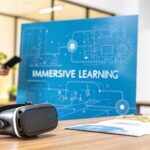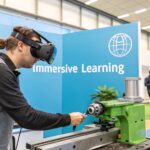What is Immersive Learning? A Guide to Its Power & Benefits
Traditional training methods often fall short of preparing employees for real-world challenges. Reading a manual or watching a video provides knowledge, but it doesn't build practical skill. This is where immersive learning changes the paradigm. It leverages technologies like Virtual Reality (VR) and Augmented Reality (AR) to place learners into realistic, interactive scenarios where they can perform tasks firsthand.
Instead of passively absorbing information, learners become active participants. They make decisions, experience the consequences of their actions, and develop tangible skills—all within a safe, controlled digital environment.
What Is Immersive Learning in Practice?
Immersive learning is a hands-on training methodology designed to build practical skills, muscle memory, and genuine confidence. It is less like studying for an exam and more like using a flight simulator, but for any conceivable professional role.
The primary goal is to close the gap between knowing what to do and knowing how to apply that knowledge under pressure. This experiential approach creates a powerful connection between the learner and the material, making it a highly effective tool for preparing individuals for complex or high-stakes responsibilities.
The Core Technology Driving the Experience
At its core, immersive learning is a powerful fusion of key technologies. Understanding their distinct roles is crucial to appreciating the effectiveness of this approach.
Virtual Reality (VR) and Augmented Reality (AR) are the two foundational pillars. While related, they serve different functions in creating a simulation.
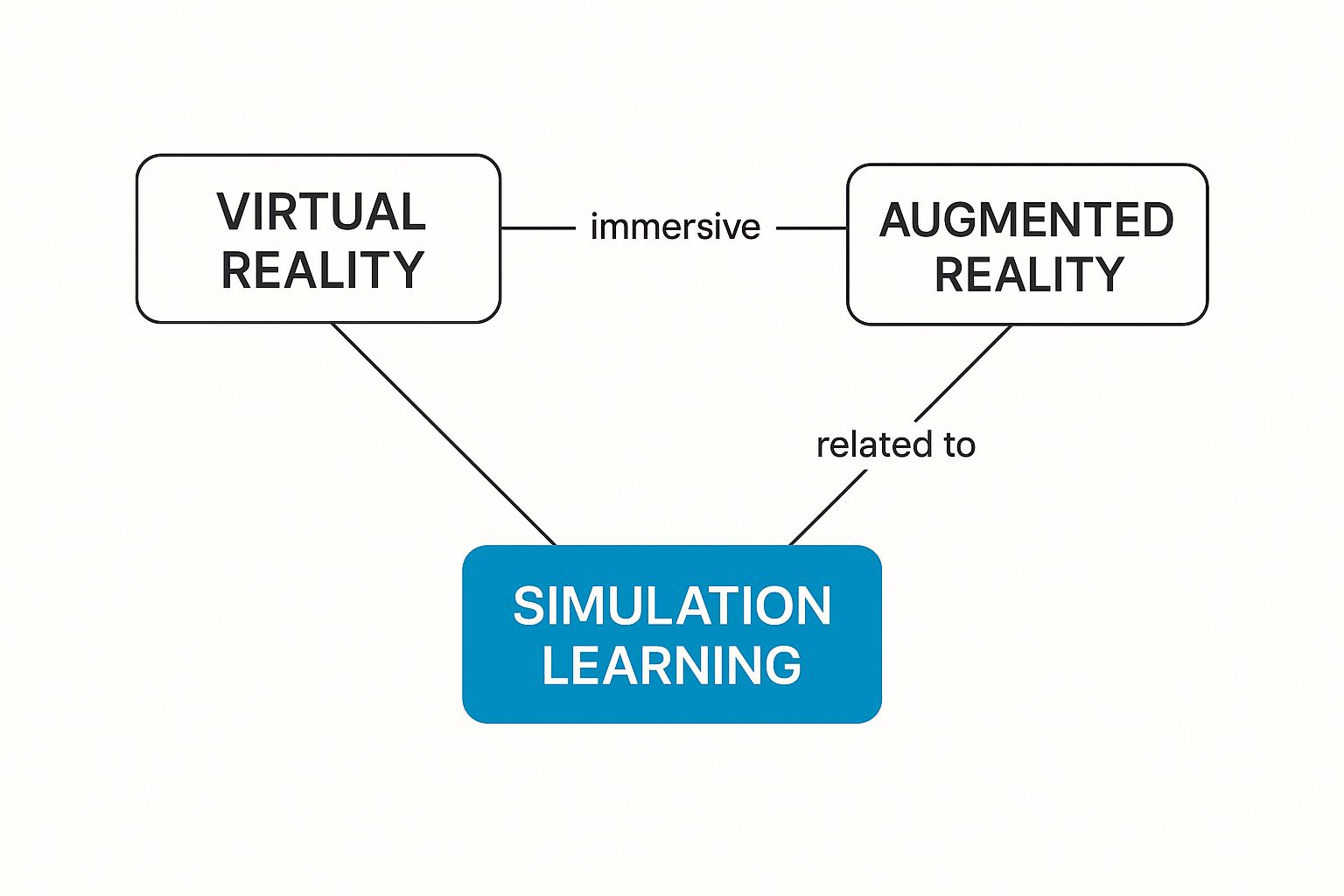
VR creates a completely digital world, fully immersing the user and shutting out physical reality. AR, conversely, keeps the user in their real-world environment but overlays digital information onto their view. Both are leveraged to create powerful, effective training simulations.
To explore this topic in greater detail, our guide on augmented reality and training is an excellent resource.
Traditional Learning vs. Immersive Learning at a Glance
The difference between theoretical knowledge and practical application is significant. This table breaks down how immersive learning compares to conventional training methods.
| Attribute | Traditional Learning (e.g., Classroom, Video) | Immersive Learning (e.g., VR, AR) |
|---|---|---|
| Engagement | Passive (Listening, Watching) | Active (Doing, Interacting) |
| Retention | Lower (Often relies on memorization) | Higher (Builds muscle memory and experience) |
| Practice | Theoretical or limited | Unlimited, hands-on practice in a safe environment |
| Risk | Real-world risks in on-the-job training | Zero risk to people or equipment |
| Feedback | Delayed (from instructor or tests) | Instant, data-driven, and contextual |
| Environment | Abstract or simulated on-screen | Realistic, context-rich, and interactive |
| Scalability | Limited by instructor/facility availability | Highly scalable, deployable anywhere |
Put simply, immersive learning is designed for action. It is not about memorizing facts; it is about building competence and instinct through direct experience.
The Technology Driving Immersive Experiences
At the heart of any immersive learning experience are key technologies working in concert to build believable, interactive worlds. These are the engines that power the simulations, transforming abstract concepts into hands-on environments.
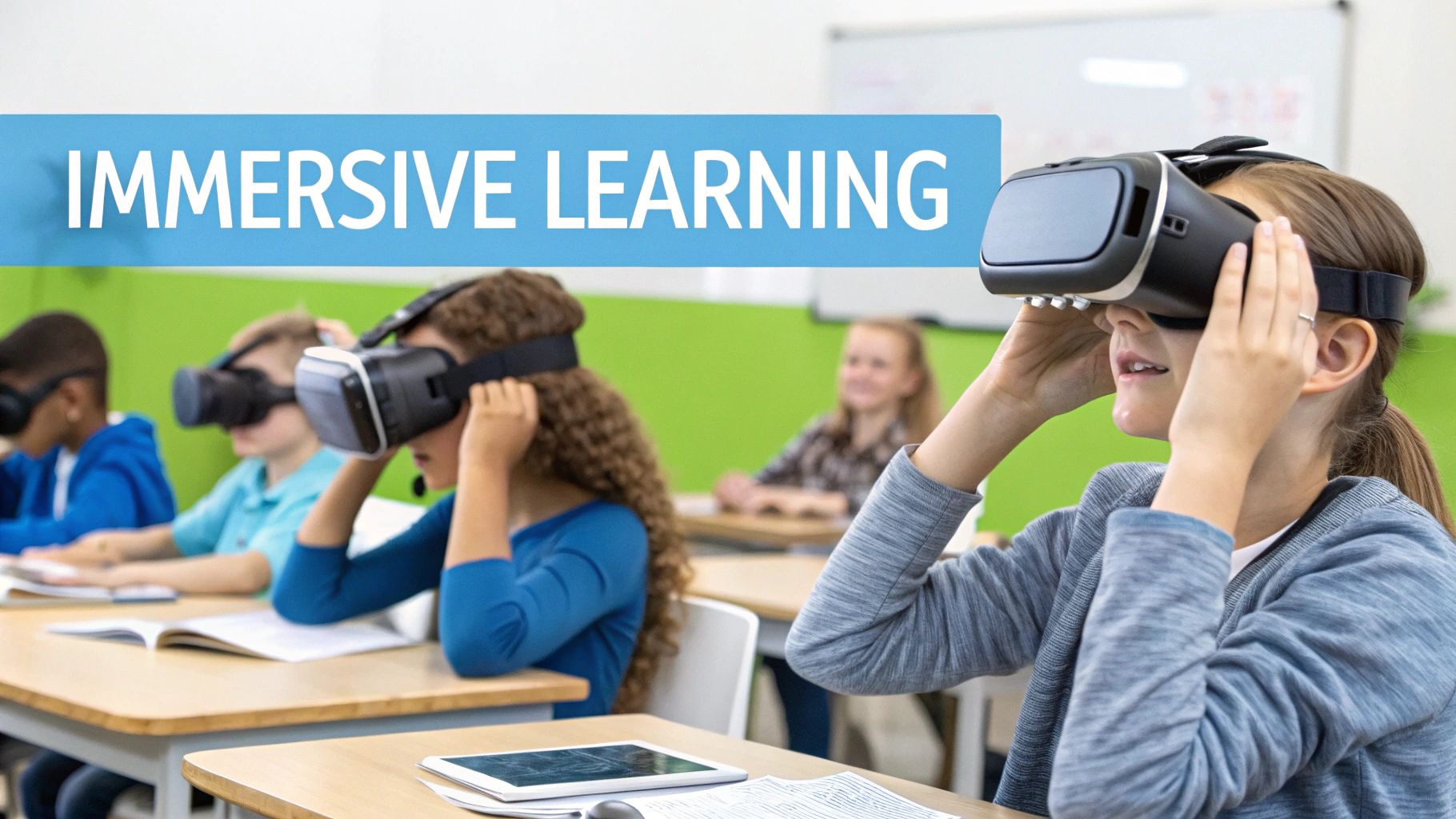
Virtual Reality (VR) uses a headset to completely replace a user's surroundings with a digital environment. This total immersion is ideal for complex simulations where recreating a scenario would be dangerous, cost-prohibitive, or physically impossible.
Augmented Reality (AR) takes a different approach. Instead of replacing the world, AR keeps users grounded in their physical space and overlays digital information onto their field of view. Delivered via smart glasses or tablets, it serves as a powerful tool for real-time, on-the-job guidance.
Key Components of an Immersive Setup
Bringing these powerful learning environments to life requires a few essential elements. The specific configuration depends on the training objective.
- Visual Hardware: This is the window into the digital world, ranging from VR headsets that create fully simulated environments to AR glasses that project information onto the real world.
- Haptic Feedback Devices: These tools, such as specialized gloves or bodysuits, simulate the sense of touch. They allow learners to feel the texture, weight, and vibration of virtual objects, making the experience more convincing and memorable.
- Sophisticated Software: This is the brain of the operation. It renders the graphics, manages user interactions, and collects performance data to track a learner’s progress and skill development.
The most effective immersive experiences don't just rely on algorithms; they are built on a solid technological foundation. Understanding how AI-powered XR needs the right infrastructure is key to building scalable and effective training programs.
Dedicated hardware can elevate the training experience. For example, using specialized Virtual Reality Pods provides a controlled and focused space that helps learners maximize the benefits of the session. When the right hardware and software are combined, they create multi-sensory experiences that make learning feel real, memorable, and impactful.
Why Top Companies Are Adopting Immersive Learning
Organizations are embracing immersive learning for a clear reason: it delivers tangible, measurable results that often surpass what traditional training can offer.
The primary driver is a significant increase in knowledge retention. When individuals learn by doing something in a simulated environment, rather than just reading about it, the lesson is more deeply ingrained. It becomes muscle memory, not just an abstract concept.
This "learning by doing" approach also provides the ultimate safety net. It gives teams a space to practice handling high-stakes, high-stress situations—from critical equipment malfunctions to medical emergencies—without any real-world risk to personnel or expensive machinery.

Driving Real Business Outcomes
The business case for immersive learning is built on practical advantages that directly impact the bottom line. This is not just about better training; it is about creating a smarter, more efficient operation.
- Significant Cost Savings: Organizations can reduce or eliminate the need for physical training mockups, cut travel expenses for instructors and trainees, and drastically reduce the costly consequences of on-the-job errors.
- Unmatched Scalability: It is possible to deliver perfectly consistent, high-quality training to a global workforce on demand. Every employee, regardless of location, receives the same top-tier instruction.
The combination of active, hands-on participation with zero-risk practice makes immersive learning a compelling solution. It's a more effective way to build skills that translates directly into better performance and a safer workplace.
Virtual reality (VR) is a cornerstone of this shift, and the data supports its efficacy. Studies consistently show that VR training leads to better retention, faster skill acquisition, and a significant boost in employee confidence compared to traditional methods. You can find more compelling VR education statistics from Takeaway Reality.
As VR and other extended reality (XR) technologies become more accessible, they are no longer a niche luxury. They represent a strategic long-term investment that offers scalable solutions with clear, proven benefits. Ultimately, leading companies are investing because this technology solves core business challenges—from enforcing safety protocols to upskilling their entire workforce, efficiently and at scale.
Real-World Immersive Learning Examples
To fully appreciate the power of immersive learning, it is essential to look beyond theory and see how companies are using it to solve complex, real-world problems. These are not hypotheticals; these are tangible results in high-stakes environments.
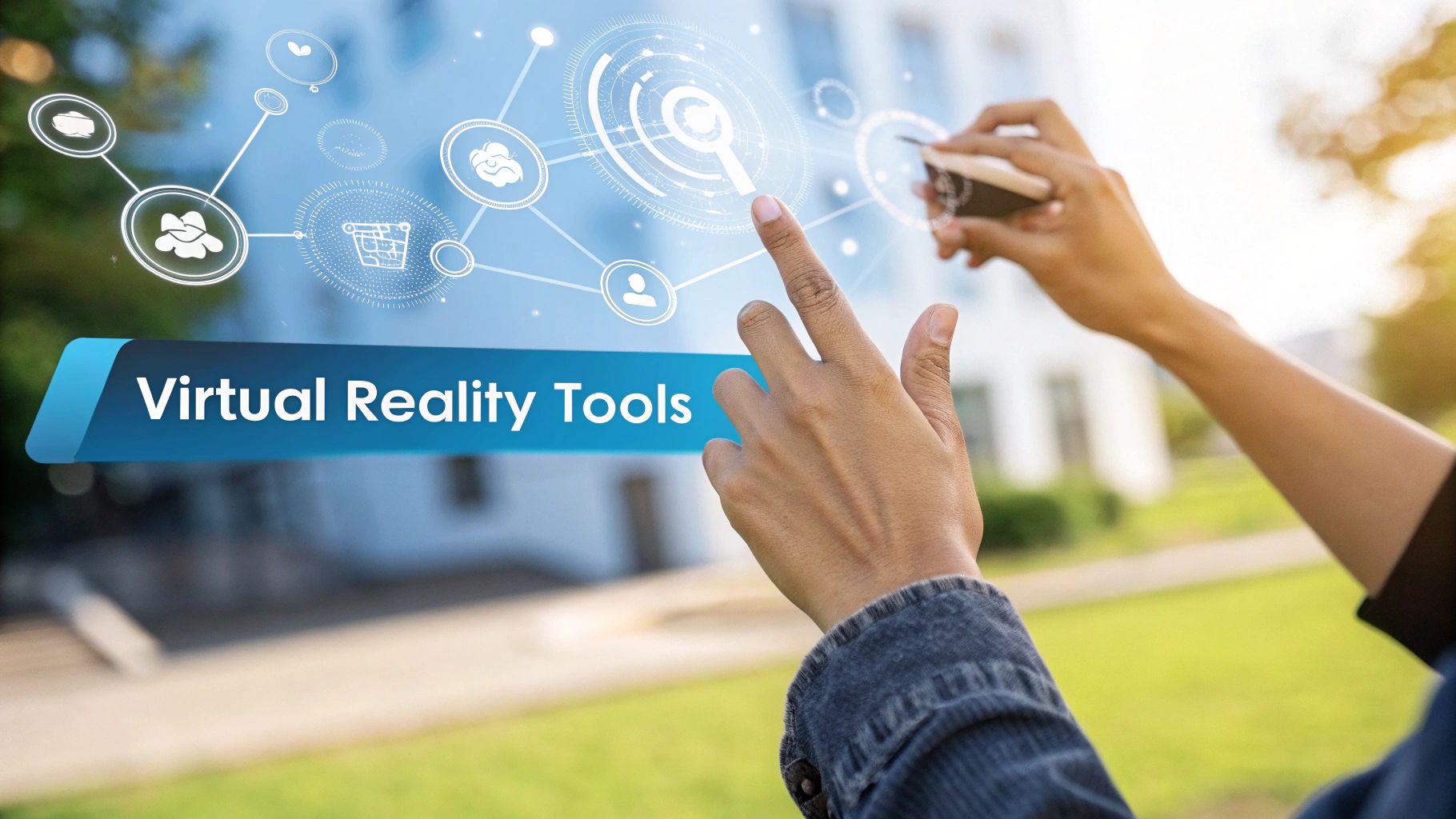
In healthcare, surgical residents use VR to practice complex procedures hundreds of times in a risk-free environment long before entering an actual operating room. This repetition is invaluable—it builds the precision and muscle memory that directly contribute to improved patient safety and surgical outcomes. Furthermore, the simulation provides every trainee with the same high-quality experience, helping to standardize excellence.
A similar story is unfolding in manufacturing, where AR is streamlining complex maintenance and repair jobs. A technician wearing AR glasses can look at a piece of machinery and see digital instructions, diagrams, and warnings overlaid directly onto the equipment. This on-the-spot guidance reduces errors, accelerates repair times, and minimizes costly equipment downtime.
Enhancing Skills Across Diverse Industries
The applications extend far beyond technical fields. Retail and customer service industries are adopting simulations to train teams on handling difficult conversations and de-escalating tense customer situations.
- Conflict Resolution: Employees practice managing interactions with upset customers in a realistic but controlled setting, building confidence and sharpening communication skills.
- Safety Protocols: Teams rehearse emergency response plans, such as fire or security threat procedures, ensuring everyone understands their role and can act cohesively when it matters most.
These practical applications prove that immersive learning is more than an interesting concept. It is a proven tool for elevating human performance, solving critical business problems, and building a more skilled and confident workforce across the board.
The growth in this sector is substantial. The immersive training market, focused specifically on job skills, was valued at approximately USD 16.4 billion in 2024. Its rapid adoption in high-stakes fields like aviation and healthcare demonstrates the value of risk-free simulation for enhancing safety and efficiency.
These examples highlight a fundamental shift in skill development that is delivering measurable improvements today. If you're curious to see more specific applications, our article on augmented reality education examples takes a deeper dive into this technology's capabilities.
How to Implement an Immersive Learning Program
Implementing immersive learning is a strategic initiative that requires a methodical, step-by-step plan to ensure it delivers results and achieves user adoption.
The process begins with a foundational question: what specific problem are you trying to solve?
Before considering hardware, you must pinpoint the business challenge or skill gap you want to address. Are you aiming to reduce safety incidents, accelerate complex repairs, or enhance your team's soft skills? Defining this objective is the most critical first step.
Once you have established your "why," you can determine the "how." This involves deciding whether a fully simulated VR environment or a real-world AR overlay is the right tool for the job.
Building and Launching Your Program
The next stage is content creation. There are two primary paths: partnering with specialists to build custom simulations tailored to your company’s unique needs, or licensing ready-made modules from a platform's library. The best choice depends on your budget and the specificity of your training requirements.
Finally, a strong program can fail without a solid rollout plan. You must consider how to integrate this new technology into your existing training workflows. This includes:
- Onboarding: How will you train users to be comfortable with the hardware and software?
- Scheduling: When and where will employees access the training modules?
- Measurement: How will you track performance and measure the program's return on investment?
A well-structured plan is the bridge between acquiring innovative technology and achieving real business outcomes. It ensures the experience is a strategic tool directly tied to performance improvement and goal attainment.
Careful consideration of these stages is essential. To understand how these pieces fit into a cohesive strategy, it is beneficial to explore the key components of a complete virtual reality training program and how they are structured for maximum impact. This is how you transition immersive learning from an interesting idea to a core component of your workforce development strategy.
The Future of Training Is Already Here
Immersive learning is no longer a futuristic concept; it is rapidly evolving from a niche technology into a core strategy for modern workforce development. As hardware becomes more powerful and affordable, its applications are expanding across new industries and job roles.
The next evolution is already taking shape. AI is being integrated to create adaptive learning paths that respond to an individual’s performance in real time, delivering truly personalized training. The rise of collaborative, multi-user VR spaces will soon allow teams from opposite ends of the globe to train together in a shared virtual environment.
This is not speculation; market growth confirms the trend. In 2024, the immersive learning market was valued at $41.1 billion and is projected to reach $631.8 billion by 2035. You can discover more insights about the immersive learning market to see just how rapidly this space is advancing.
For any organization serious about building a resilient, highly skilled, and adaptable workforce, the question is no longer if they should adopt immersive learning, but how soon they can start.
This trend points to a fundamental shift in how we build and maintain skills. For more insights into the evolving landscape of training and future innovations, the Buddypro's blog is a valuable resource.
Common Questions About Immersive Learning
As businesses explore immersive learning, several practical questions consistently arise. Addressing these is key to making an informed decision.
Is Immersive Learning Expensive to Implement?
While there is an initial investment in hardware and content development, the true value lies in the Return on Investment (ROI).
Consider the long-term savings: reduced travel costs for trainers and trainees, less wear-and-tear on physical equipment, and minimized financial impact from on-the-job mistakes. Once implemented, an immersive learning program can be scaled efficiently, making it more cost-effective over time than repeating resource-intensive, in-person training.
How Do I Choose Between VR and AR?
The choice depends entirely on your training goal. The technology should serve the objective, not the other way around.
-
Choose Virtual Reality (VR) when you need to place a learner in a completely different, fully simulated environment. It is ideal for practicing high-stakes situations, such as complex surgery or emergency shutdowns, where real-world errors are unacceptable.
-
Choose Augmented Reality (AR) when you need to overlay digital information onto the real world. It acts as on-the-job digital guidance, perfect for helping technicians follow a complex repair sequence or guiding warehouse workers to the correct inventory.
At AIDAR Solutions, we create VR and AR programs that deliver real, measurable results. From accelerating new hire onboarding to reducing operational costs, our solutions are designed to meet your business objectives.
Ready to see how it works? Explore our offerings at https://aidarsolutions.com and discover what immersive learning can do for you.

